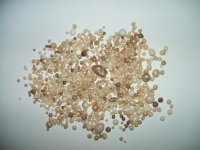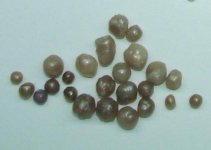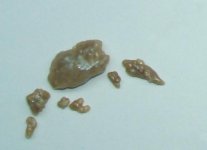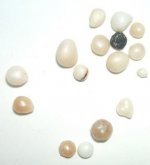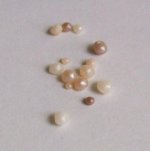Lagoon Island Pearls
Well-known member
- Joined
- Dec 8, 2009
- Messages
- 2,143
First of all, thank you to the administrators for allowing me to join your discussion group. I'm no less than wholly impressed at the high level of professionalism and interest expressed here.
My name is Dave LeBlanc. I live in British Columbia, Canada. Several years ago, while living on Vancouver Island, I held two provincial foreshore leases, where I experimented in the viability of harvesting, conditioning, and rearing of edible clams (Venerupus phillipinarium) and pearl culture in California mussels (Mytilus californianus).
While admittedly neither a marine biologist nor gemologist, I have extensive background as a deep sea diver. During my time as a diver, harvested geoduck clams, red/green sea urchins, abalone, marine plants, barnacles and sea cuccumbers. Not all of these harvestings were for the food industry, but some (namely octopus and barnacles) were harvested for research purposes in either biomass/growth rate studies or spinal cord research.
Due to the onset of debilitating arthritis, I was forced into early retirement from diving at the ripe old age of 26, when I re-adjusted my studies to the intertidal zone.
The waters of Clayoquot Sound and Meares Island are a pristine environment, hundreds of kilometers from major industrial pollution sources. I selected a site within an area known as Lemmens Inlet. This inlet is quite unique on a global scale, apparently having more species per unit square, second only to the Red Sea. There is a thriving oyster culture within Lemmens Inlet, which produce an estimated 50,000 gallons annually of fast growing contaminant-free product.
I was considering aquiring a lease for oyster production in the area and scouted several locations. Most oyster culture takes place "off bottom". Spat is suspended on strings and floated by barrels for grow out. The intial cost in this method is high, because of the cost of flotation, line and anchors. I sought a location, where I could experiment in bottom culture, escaping some costs. In my surveys, I discovered a very remarkable place. Nestled in the heart of Lemmens Inlet, is Lagoon Island. Aptly named because the upland surrounding an intertidal lagoon. One of the major factors in determining a provincial foreshore lease, is non-alienation of other user groups or species. The Lagoon is strewn with large California mussels, which is not a common thing within inland waterways. Mytilus c., for the mostpart, habituates along the wave pounded shores of the surf line.
To this day, it's not clearly known why these mussels occur as an adjunct species, but presumably because of food sources and temperature as well as a lack of natural predation, even though multiple predators are present in the region.
I knew natural pearls are found in local oysters, but they are of no great value, being concretions. This led me to examine the mussels, which have a nacreous shell lining. Fortunately for me, any natural pearls I find, are "in situ", therefore can be closely examined in their pathology.
My collection of natural pearls, is a combination of incidence biomass study through measured units expanded over a region where the animals were sacrificed as well as incidental harvests from implant experiments.
Understandably, my experiments were crude science at best, but having found more than a thousand naturals, I have an intimate knowledge of how pearls most often occur within the anatomy of a mussel. While some of my pearls are concretions, most are nacreous. Although I have found some pearls up to 2cm, they are tiny for the mostpart.
These pearls had very little attention from industry experts to this day. Only once, did I have a gemologist examine my pearls. In the absence of certification and report details, he was impressed by the quality of the surfaces. It's important to note, these pearls have been out of water for nearly two decades and kept in a dark container. I sincerely apologize for the low imgage quality, as I only have a 5.2 mp camera and no tripod. I have been asked by Dr. Stern, to provide high resolution images, but should probably include a few samples for examination. That said, I would be happy to provide a sample to anyone certified in the field, in exchange for a detailed report.
I suppose I could go on forever and a day about these little beauties, but will leave it for further discussion and questions within this forum. Again, I am pleased to be here and look forward to things to come.
My name is Dave LeBlanc. I live in British Columbia, Canada. Several years ago, while living on Vancouver Island, I held two provincial foreshore leases, where I experimented in the viability of harvesting, conditioning, and rearing of edible clams (Venerupus phillipinarium) and pearl culture in California mussels (Mytilus californianus).
While admittedly neither a marine biologist nor gemologist, I have extensive background as a deep sea diver. During my time as a diver, harvested geoduck clams, red/green sea urchins, abalone, marine plants, barnacles and sea cuccumbers. Not all of these harvestings were for the food industry, but some (namely octopus and barnacles) were harvested for research purposes in either biomass/growth rate studies or spinal cord research.
Due to the onset of debilitating arthritis, I was forced into early retirement from diving at the ripe old age of 26, when I re-adjusted my studies to the intertidal zone.
The waters of Clayoquot Sound and Meares Island are a pristine environment, hundreds of kilometers from major industrial pollution sources. I selected a site within an area known as Lemmens Inlet. This inlet is quite unique on a global scale, apparently having more species per unit square, second only to the Red Sea. There is a thriving oyster culture within Lemmens Inlet, which produce an estimated 50,000 gallons annually of fast growing contaminant-free product.
I was considering aquiring a lease for oyster production in the area and scouted several locations. Most oyster culture takes place "off bottom". Spat is suspended on strings and floated by barrels for grow out. The intial cost in this method is high, because of the cost of flotation, line and anchors. I sought a location, where I could experiment in bottom culture, escaping some costs. In my surveys, I discovered a very remarkable place. Nestled in the heart of Lemmens Inlet, is Lagoon Island. Aptly named because the upland surrounding an intertidal lagoon. One of the major factors in determining a provincial foreshore lease, is non-alienation of other user groups or species. The Lagoon is strewn with large California mussels, which is not a common thing within inland waterways. Mytilus c., for the mostpart, habituates along the wave pounded shores of the surf line.
To this day, it's not clearly known why these mussels occur as an adjunct species, but presumably because of food sources and temperature as well as a lack of natural predation, even though multiple predators are present in the region.
I knew natural pearls are found in local oysters, but they are of no great value, being concretions. This led me to examine the mussels, which have a nacreous shell lining. Fortunately for me, any natural pearls I find, are "in situ", therefore can be closely examined in their pathology.
My collection of natural pearls, is a combination of incidence biomass study through measured units expanded over a region where the animals were sacrificed as well as incidental harvests from implant experiments.
Understandably, my experiments were crude science at best, but having found more than a thousand naturals, I have an intimate knowledge of how pearls most often occur within the anatomy of a mussel. While some of my pearls are concretions, most are nacreous. Although I have found some pearls up to 2cm, they are tiny for the mostpart.
These pearls had very little attention from industry experts to this day. Only once, did I have a gemologist examine my pearls. In the absence of certification and report details, he was impressed by the quality of the surfaces. It's important to note, these pearls have been out of water for nearly two decades and kept in a dark container. I sincerely apologize for the low imgage quality, as I only have a 5.2 mp camera and no tripod. I have been asked by Dr. Stern, to provide high resolution images, but should probably include a few samples for examination. That said, I would be happy to provide a sample to anyone certified in the field, in exchange for a detailed report.
I suppose I could go on forever and a day about these little beauties, but will leave it for further discussion and questions within this forum. Again, I am pleased to be here and look forward to things to come.

